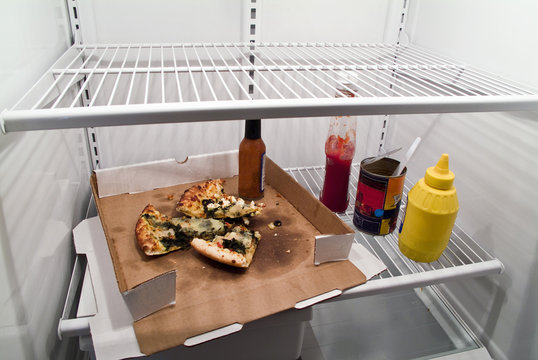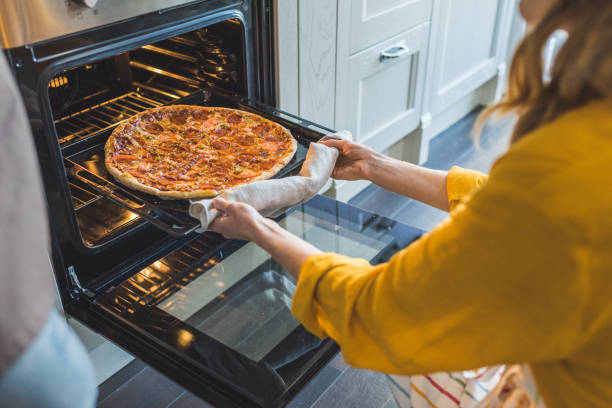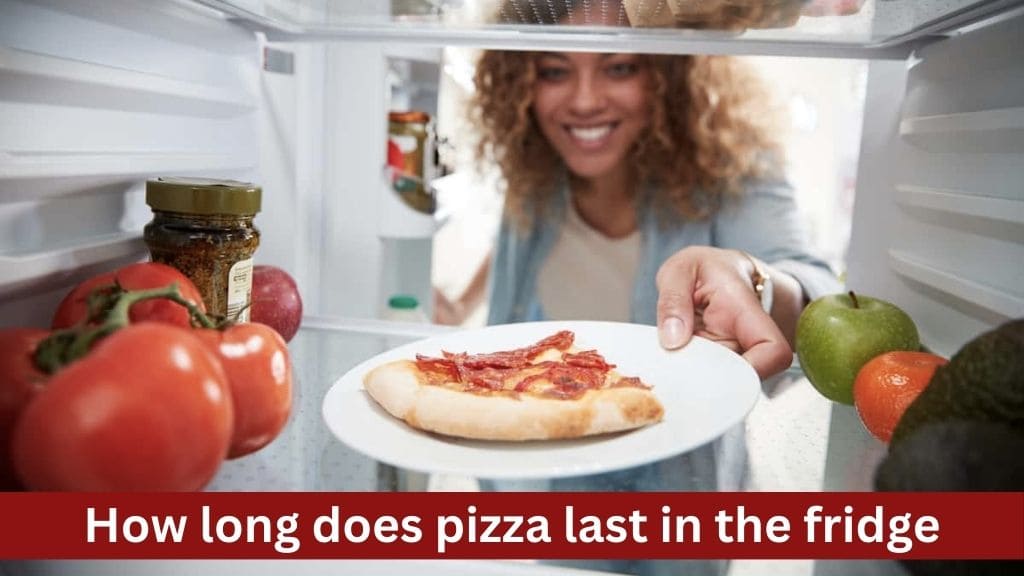Pizza, the beloved Italian dish, is a favorite among many households worldwide. Whether it’s a classic Margherita, a meat lover’s delight, or a veggie-packed masterpiece, pizza is versatile and delicious. However, as much as we love indulging in a fresh slice, it’s not uncommon to have leftovers. So, the question arises: how long does pizza last in the fridge? In this comprehensive guide, we’ll explore everything you need to know about storing pizza in the refrigerator, including storage guidelines, tips for extending its shelf life, and safe reheating methods.
Understanding Pizza Storage Guidelines

When it comes to storing leftover pizza, it’s essential to understand food safety guidelines to prevent foodborne illness. Here’s what you need to know:
The Two-Hour Rule
The Two-Hour Rule is a food safety guideline recommended by the United States Department of Agriculture (USDA) to minimize the risk of foodborne illness. According to this rule, perishable foods, including pizza, should not be left out at room temperature for more than two hours.
The rationale behind the Two-Hour Rule lies in the concept of the “Danger Zone,” which refers to temperatures between 40°F (4°C) and 140°F (60°C). Within this temperature range, bacteria multiply rapidly, increasing the risk of foodborne pathogens such as Salmonella, E. coli, and Listeria.
When food is left out at room temperature for an extended period, particularly in the Danger Zone, bacteria can proliferate, leading to potential food poisoning upon consumption. This is why it’s crucial to refrigerate perishable foods promptly, especially after they’ve been cooked or served.
Refrigeration is Key
“Refrigeration is Key” emphasizes the importance of promptly storing perishable foods, such as pizza, in the refrigerator to maintain their freshness, quality, and safety.
When food is refrigerated, it is exposed to lower temperatures, typically around 40°F (4°C), which slows down the growth of bacteria and other microorganisms that can cause foodborne illness. This controlled environment helps to preserve the integrity of the food and extends its shelf life.
For leftover pizza, refrigeration is essential to prevent the growth of harmful bacteria that can multiply rapidly at room temperature. By promptly placing pizza in the refrigerator after it has been cooked or served, you create an environment that inhibits bacterial growth and reduces the risk of foodborne illness.
Additionally, refrigeration helps to retain the flavor, texture, and moisture of the pizza, ensuring that it remains enjoyable when reheated and consumed later. Without proper refrigeration, leftover pizza may spoil more quickly, leading to food waste and potential health risks.
How Long Does Pizza Last in the Fridge?

Now that we understand the importance of refrigeration, let’s explore how long pizza can last in the fridge:
USDA Guidelines
The USDA Guidelines refer to the food safety recommendations provided by the United States Department of Agriculture (USDA) regarding the storage and handling of perishable foods, including leftover pizza.
These guidelines serve as a comprehensive resource to help consumers understand best practices for ensuring food safety and preventing foodborne illness. Specifically concerning pizza storage, the USDA provides recommendations on how long pizza can safely be stored in the refrigerator and freezer.
For leftover pizza stored in the refrigerator, the USDA advises that it can remain safe for consumption for up to four days, provided that it was refrigerated within two hours of cooking or serving. This timeframe takes into account the potential growth of bacteria, which can occur if pizza is left at room temperature for too long.
The USDA also emphasizes the importance of proper storage techniques, such as wrapping pizza tightly in aluminum foil, plastic wrap, or storing it in an airtight container to prevent air exposure and moisture loss. Labeling and dating the container or wrapping can help consumers keep track of how long the pizza has been in the fridge, ensuring its freshness and safety.
Additionally, the USDA provides guidance on freezing leftover pizza for extended storage. While pizza can remain safe for consumption in the freezer for one to two months, the USDA recommends using proper wrapping techniques, such as aluminum foil or freezer bags, to maintain its quality and prevent freezer burn.
Proper Storage Techniques
To maximize the shelf life of leftover pizza in the fridge, it’s essential to employ proper storage techniques:
- Wrapping: One of the most important aspects of proper storage is wrapping the leftover pizza tightly. This helps to prevent air exposure, which can lead to moisture loss and potential spoilage. Options for wrapping include aluminum foil, plastic wrap, or placing the pizza in an airtight container.
- Choosing the Right Container: If using an airtight container, ensure it is clean and free from any previous food residues. Opt for containers that are specifically designed for food storage to maintain freshness and prevent odors from transferring to the pizza.
- Labeling and Dating: It’s helpful to label the container or wrapping with the date the pizza was stored. This allows you to track how long it has been in the fridge and ensures you consume it before it exceeds its recommended storage time.
- Storage Location: Place the wrapped or containerized pizza in the refrigerator’s main compartment rather than the door. The main compartment maintains a more consistent temperature, which helps to preserve the pizza’s quality for a longer period.
- Avoid Overcrowding: When storing multiple slices or containers of pizza, avoid overcrowding the refrigerator. Ensuring proper airflow around each slice or container helps to maintain consistent temperature levels and prevents uneven cooling, which can lead to spoilage.
- Refrigerate Promptly: Promptly refrigerate leftover pizza within two hours of cooking or serving. This helps to minimize the time the pizza spends in the “Danger Zone” temperature range (40°F to 140°F), where bacteria multiply rapidly.
Extending Pizza Shelf Life in the Freezer

If you anticipate not consuming leftover pizza within the four-day timeframe, freezing is an excellent option for extending its shelf life:
Freezing Guidelines
When freezing leftover pizza, follow these guidelines to maintain its quality:
- Wrap Properly: Use suitable materials such as aluminum foil, plastic wrap, or freezer bags to wrap individual slices or the entire pizza securely. The wrapping acts as a barrier against air exposure, preventing moisture loss and freezer burn. Ensure the wrap is tight and covers the pizza completely to maintain its freshness.
- Remove Excess Air: Before sealing the wrapped pizza, press out any excess air from the packaging. Air trapped inside the wrapping can lead to freezer burn, which can affect the pizza’s taste and texture over time. Removing excess air helps preserve the quality of the pizza during freezing.
- Label and Date: It’s essential to label the wrapped pizza with the date it was frozen. This allows you to track how long it has been in the freezer and ensures you consume it before its quality deteriorates. Use a permanent marker to write the date clearly on the wrapping or container.
- Proper Storage Location: Place the wrapped pizza in the freezer’s coldest section, typically towards the back or bottom. Avoid placing it near the freezer door, as frequent opening and closing can cause temperature fluctuations that may affect the pizza’s quality. Ensuring consistent and stable freezing temperatures helps preserve the pizza’s taste and texture.
- Maintain Freezer Temperature: Keep the freezer temperature at 0°F (-18°C) or below to ensure optimal food preservation. Fluctuations in temperature can impact the quality of the frozen pizza, so it’s essential to monitor and adjust the freezer settings as needed to maintain the recommended temperature.
Freezer Shelf Life
- Optimal Freezer Conditions: The freezer shelf life of pizza depends on several factors, including the quality of wrapping, storage temperature, and how well the pizza was prepared before freezing. Maintaining the freezer temperature at 0°F (-18°C) or below is crucial for preserving the pizza’s taste and texture.
- Recommended Duration: While pizza can technically remain safe to eat for much longer when stored in the freezer, it’s generally recommended to consume it within one to two months for optimal quality. Beyond this timeframe, the pizza may begin to experience changes in flavor, texture, and overall quality due to freezer burn or degradation of ingredients.
- Quality Considerations: Although frozen pizza may still be safe to eat after the recommended shelf life, its quality may gradually decline over time. Freezer burn, which occurs when moisture evaporates from the pizza’s surface, can affect its taste and texture. Additionally, ingredients like cheese and toppings may lose their freshness and flavor over extended periods in the freezer.
- Storage Techniques: Proper wrapping and storage techniques play a significant role in extending the freezer shelf life of pizza. Wrapping the pizza tightly in aluminum foil, plastic wrap, or freezer bags helps prevent air exposure and moisture loss, reducing the risk of freezer burn. Labeling and dating the packaging also help track the pizza’s storage time and ensure it is consumed within the recommended timeframe.
- Quality Assessment: Before consuming frozen pizza that has been stored for an extended period, it’s essential to inspect it for any signs of freezer burn, changes in color or texture, or off-putting odors. If the pizza appears to be significantly degraded or has developed an unusual smell, it’s best to discard it to avoid potential food safety issues.
Safe Reheating Methods

Safe reheating methods are essential for ensuring that leftover pizza is heated thoroughly and consumed safely without compromising its taste or texture. Here’s a deeper explanation of safe reheating methods for pizza:
- Even Heating: One of the primary goals of safe reheating methods is to ensure that the pizza is heated evenly throughout. This helps eliminate any potential cold spots where bacteria could survive, reducing the risk of foodborne illness.
- Preservation of Texture: While reheating, it’s important to preserve the pizza’s texture, especially the crust. Reheating methods should aim to maintain the crust’s crispiness or chewiness, depending on personal preference, while ensuring that the cheese and toppings are adequately heated.
- Prevention of Overheating: Overheating pizza can lead to dryness and a loss of flavor. Safe reheating methods should aim to heat the pizza to the desired temperature without overheating it, which can compromise its quality.
- Avoidance of Hot Spots: Microwave reheating, in particular, can create hot spots in the pizza, where some areas are significantly hotter than others. Safe reheating methods should address this issue to ensure that the entire pizza is heated uniformly.
- Utilization of Proper Equipment: Different reheating methods may require different equipment, such as ovens, microwaves, frying pans, or air fryers. It’s essential to use the appropriate equipment for the chosen reheating method to achieve the best results.
- Monitoring of Temperature: When reheating pizza, it’s a good idea to use a food thermometer to ensure that it reaches a safe internal temperature of 165°F (74°C). This temperature kills any potential bacteria present in the pizza, reducing the risk of foodborne illness.
- Personalization: Safe reheating methods should also allow for personalization based on individual preferences. Some people may prefer their pizza reheated in the oven for a crispy crust, while others may opt for the convenience of microwave reheating.
Conclusion
Leftover pizza can be safely stored in the refrigerator for up to four days, provided the two-hour rule is followed. By employing proper storage techniques and utilizing safe reheating methods, you can extend the shelf life of leftover pizza and enjoy it at its best. Whether you’re reheating in the oven, microwave, or skillet, following these guidelines will help you savor every delicious bite of your favorite pizza. So, the next time you have leftover pizza, rest assured knowing you can enjoy it safely and deliciously!

